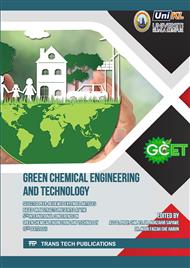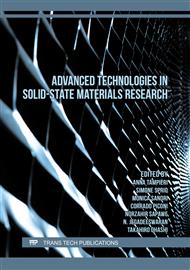[1]
I. Fatimah, Green synthesis of silver nanoparticles using extract of Parkia speciosa Hassk pods assisted by microwave irradiation, J. Adv. Res. 7 (2016) 961-969.
DOI: 10.1016/j.jare.2016.10.002
Google Scholar
[2]
S. Parveen, R. Misra, S.K. Sahoo, Nanoparticles: a boon to drug delivery, therapeutics, diagnostics and imaging, Nanomed.: Nanotechnol. Biol. Med. 8 (2012) 147-166.
DOI: 10.1016/j.nano.2011.05.016
Google Scholar
[3]
J. Phillips, W. Bowen, E. Cagin, W. Wang, Electronic and optoelectronic devices based on semiconducting zinc oxide, Compr. Semicond. Sci. Technol. 6 (2011) 101-127.
DOI: 10.1016/b978-0-44-453153-7.00025-0
Google Scholar
[4]
K. Saranyaadevi, V. Subha, R.S. Ernest Ravindran, S. Renganathan, Green synthesis and characterization of silver nanoparticle using leaf extract of Capparis zeylanica, Asian J. Pharm. Clin. Res. 7 (2014) 44-48.
Google Scholar
[5]
K. Tokarek, J.L. Hueso, P. Kuśtrowski, G. Stochel, A. Kyzioł, Green synthesis of chitosan-stabilized copper nanoparticles, Eur. J. Inorg. Chem. (2013) 4940-4947.
DOI: 10.1002/ejic.201300594
Google Scholar
[6]
C.P. Jiménez-Gómez, J.A. Cecilia, Chitosan: a natural biopolymer with a wide and varied range of applications, Molecules 25 (2020) 1-43.
DOI: 10.3390/molecules25173981
Google Scholar
[7]
M.D. Nguyen, H.V. Tran, S. Xu, T.R. Lee, Fe3O4 nanoparticles: structures, synthesis, magnetic properties, surface functionalization, and emerging applications, Appl. Sci. 11 (2021) 1-34.
DOI: 10.3390/app112311301
Google Scholar
[8]
F. Fahmiati, N. Nuryono, S. Suyanta, Characteristics of iron sand magnetic material from Bugel beach, Kulon Progo, Yogyakarta, IOP Conf. Series: Mater. Sci. Engineer. 172 (2017) 1-8.
DOI: 10.1088/1757-899x/172/1/012020
Google Scholar
[9]
N. Nuryono, D. Miswanda, S.C.W. Sakti, B. Rusdiarso, P.A. Krisbiantoro, N. Utami, R. Otomo, Y. Kamiya, Chitosan-functionalized natural magnetic particle@silica modified with (3-chloropropyl)trimetoxysilane as a highly stable magnetic adsorbent for gold(III) ion, Mater. Chem. and Phys. 255 (2020) 1-11.
DOI: 10.1016/j.matchemphys.2020.123507
Google Scholar
[10]
K.N. Thakkar, S.S. Mhatre, R.Y. Parikh, Biological synthesis of metallic nanoparticles, Nanomed: Nanotechnol. Biol. Med. 6 (2010) 257-262.
Google Scholar
[11]
N.M. Zain, A.G.F. Stapley, G. Shama, Green synthesis of silver and copper nanoparticles using ascorbic acid and chitosan for antimicrobial applications, Carbohydr. Polym. 112 (2014) 195-202.
DOI: 10.1016/j.carbpol.2014.05.081
Google Scholar
[12]
A. Manikandan, M. Sathiyabama, Green synthesis of copper-chitosan nanoparticles and study of its antibacterial activity, J. Nanomed. Nanotechnol. 6 (2015) 1-5.
Google Scholar
[13]
R.C. Goy, S.T.B. Morais, O.B.G. Assis, Evaluation of the antimicrobial activity of chitosan and its quaternized derivative on E. Coli and S. aureus growth, Rev. Bras. Farmacogn. 26 (2016) 122-127.
DOI: 10.1016/j.bjp.2015.09.010
Google Scholar
[14]
P. Lignier, R. Bellabarba, R.P. Tooze, Scalable strategies for the synthesis of well-defined copper metal and oxide nanocrystals, Chem. Soc. Rev. 41 (2012) 1708-1720.
DOI: 10.1039/c1cs15223h
Google Scholar
[15]
W. Yu, H. Xie, L. Chen, Y. Li, C. Zhang, Synthesis and characterization of monodispersed copper colloids in polar solvents, Nanoscale Res. Lett. 4 (2009) 465-470.
DOI: 10.1007/s11671-009-9264-3
Google Scholar
[16]
B.K. Park, S. Jeong, D. Kim, J. Moon, S. Lim, J.S. Kim, Synthesis and size control of monodisperse copper nanoparticles by polyol method, J. Colloid Interface Sci. 311 (2007) 417-424.
DOI: 10.1016/j.jcis.2007.03.039
Google Scholar
[17]
S.H. Lim, S.M. Hudson, Application of a fiber-reactive chitosan derivative to cotton fabric as an antimicrobial textile finish, Carbohydr. Polym. 56 (2004) 227-234.
DOI: 10.1016/j.carbpol.2004.02.005
Google Scholar
[18]
M. Bhagat, R. Anand, P. Sharma, P. Rajput, N. Sharma, K. Singh, Review—Multifunctional Copper Nanoparticles: Synthesis and Applications, ECS J. Solid State Sci. Technol. 10 (2021) 063011.
DOI: 10.1149/2162-8777/ac07f8
Google Scholar
[19]
T.M. Tolaymat, A.M. El Badawy, A. Genaidy, K.G. Scheckel, T.P. Luxton, M. Suidan, An evidence-based environmental perspective of manufactured silver nanoparticle in syntheses and applications: a systematic review and critical appraisal of peer-reviewed scientific papers, Sci. Total Environ. 408 (2010) 999-1006.
DOI: 10.1016/j.scitotenv.2009.11.003
Google Scholar
[20]
M.W. Choi, M.H. Bae, J.H. Ahn, Synthesis of copper nanoparticles by a chemical reduction method, J. Korean Powder Metall. Inst. 23 (2016) 228-234.
DOI: 10.4150/kpmi.2016.23.3.228
Google Scholar
[21]
P.K. Khanna, T.S. Kale, M. Shaikh, N.K. Rao, C.V.V. Satyanarayana, Synthesis of oleic acid capped copper nano-particles via reduction of copper salt by SFS, Mater. Chem. Phys. 110 (2008) 21-25.
DOI: 10.1016/j.matchemphys.2008.01.013
Google Scholar
[22]
D. Deng, Y. Cheng, Y. Jin, T. Qi, F. Xiao, Antioxidative effect of lactic acid-stabilized copper nanoparticles prepared in aqueous solution, J. Mater. Chem. 22 (2012) 23989-23995.
DOI: 10.1039/c2jm35041f
Google Scholar
[23]
G. Cárdenas, J. Díaz-Visurraga, M.F. Meléndrez, C.A. Cruzat-Contreras, A.G. Cancino, Colloidal Cu nanoparticles/chitosan composite film obtained by microwave heating for food package applications, Polym. Bull. 62 (2009) 511-524.
DOI: 10.1007/s00289-008-0031-x
Google Scholar
[24]
M.E. Villamin, Y. Kitamoto, Synthesis of multifunctional clustered nano-Fe3O4 chitosan nanocomposite for biomedical applications, AIP Conf. Proc. 1929 (2018) 1-6.
DOI: 10.1063/1.5021927
Google Scholar



